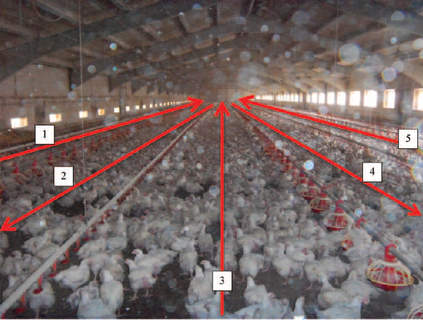|
5/10/2021 0 Comments Transect method reflects environmental inputs and production outcomes on broiler farms 5 transects in a broiler house (Marchewka et al. 2013) 5 transects in a broiler house (Marchewka et al. 2013) by Shawna Weimer - Assessing the welfare of individual broiler chickens in large flocks is difficult. The transect method offers a reliable way to perform a walk-through inspection of broiler flock welfare. Transect sampling is intended for practical use by farmers, flock supervisors, veterinarians, and animal welfare auditors to obtain a quick but quantitative snapshot of the current welfare status of a flock. The transect method is performed by a human that slowly walks along successive transects, or rows between the feeder and drinker lines (1-5 in the image), and records the number of birds observed to have the following welfare problems: walking difficulties (lame, immobile), illness (sick, terminally ill, dead), skin wounds (on the head, back, and tail), small, dirty, and featherless. While differences in the observations between the people performing the transect method can potentially mask the differences in welfare status between flocks, the transect method has been shown to reveal differences in the welfare of flocks raised in different environmental conditions. In a study by BenSassi and colleagues in 2019, researchers investigated the relationships between 4 environmental factors: (environmental enrichments, stocking density, presence or absence of underfloor heating, and a photoperiod of either 16 hour intermittent vs. 18 hour continuous hours of light during a 24-hour period), with transect data, and production (foot pad dermatitis score, growth rate, feed conversion, mortality, carcass weight, and plant rejection) data of 29 flocks from 15 commercial broiler farms in Norway. A few notable findings from this study:
This research highlights the relationships between environmental management and broiler welfare on-farm. The authors concluded that the welfare of broiler flocks could be improved by adding environmental enrichments, underfloor heating, 16 hour intermittent lighting (two 4-hour dark periods), and decreasing stocking density and that recording animal-based measures on broiler farms can add value to welfare assessments. Access the full article "On-farm broiler chicken welfare assessment using transect sampling reflects environmental inputs and production outcomes" by BenSassi et al., 2019 in PLOS One here Access the image full article "Welfare assessment in broiler farms: Transect walks versus individual scoring" by Marchewka et al., 2013 in Poultry Science here
0 Comments
Leave a Reply. |
Authors: PECWe are here to make poultry welfare science accessible Archives
June 2023
|
 RSS Feed
RSS Feed
